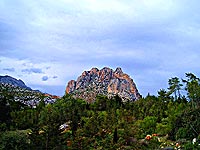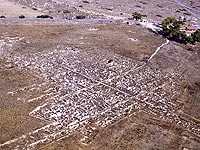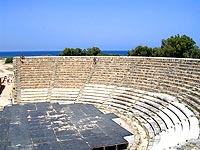
Legends and myths of North Cyprus include Aphrodite, heroes, hidden treasures, saints and more.
 |
the north cyprus travel guide |
 |
|
Legends & MythsHome to goddesses, giants and saints, North Cyprus has legends to spare. Heroes, Maidens and Mountains in North Cyprus
When you want a hero to be strong, he has to be able to move mountains! So it’s not surprising that the great hero of North Cyprus, Dhiyenis Akritas, is supposedly responsible for the creation of the dramatic Kyrenia mountain range. When this hero leapt across the sea from Anatolia to save Cyprus from the Saracen invaders, legend tells how he left his handprint in the soil of North Cyprus, his five fingers forming the jagged peaks of the mountains. Hence, they are often known as the Five Finger Mountain of Northern Cyprus. Another legend about the Kyrenia Mountains in North Cyprus is much more romantic! A humble villager fell in love with his ruling queen, and had the audacity to ask for her hand in marriage. In order to be rid of this upstart young man, the queen sent him on a perilous journey, to fetch a skin of water from the spring at the St Andreas monastery. Much to her surprise, he succeeded and returned with the requested water, but she still refused to marry him. In disgust, the villager poured the water on the ground, grabbed a lump of the mud created by the resulting puddle of water, and threw it at the queen’s head. She avoided the mud, which flew through the air and stuck on the mountain ridge beyond. To this day, the North Cyprus Kyrenia Mountains still show the impression of the furious villager’s five fingers! The Horned God of Enkomi-Alasia, North Cyprus
There may not be much to see at the Bronze Age site of Enkomi-Alasia in Northern Cyprus today, thanks to earthquakes, but from the sixteenth century BC copper was exported from its harbour to Egypt. This important archaeological site in North Cyprus, first excavated in 1896, yielded important finds, including a silver bowl engraved with ox-head designs. This, combined with the discovery of a tablet written in Cypro-Minoen script, may link this Bronze Age copper town in North Cyprus to the famous legend of another island, Crete. There, the famous labyrinth at the palace of Knossos housed the Minotaur, a beast who was half-man, half-bull. Another find was the two-foot high bronze statue of the Horned God, in a sanctuary marked by stone horns. The area was also filled with the skulls of animals, perhaps worn by members of his cult. Objects found under the floor of this important shrine in Northern Cyprus date from as early as the sixteenth century BC, so the cult of the god was there right from the beginning of the city’s prosperity. The North Cyprus city of Enkomi-Alasia was abandoned in the eleventh century BC after extensive earthquake damage, when the residents probably moved to Salamis. North Cyprus’ Returning Heroes
When the famous siege of Troy ended, thousands of victorious warriors finally could return home after ten long years of combat. Teucer, brother of the Greek hero Ajax and son of Telamon, came to Cyprus and, according to legend, founded the city of Salamis. Considered to be the main city of the whole of Cyprus during the 7th century BC, today, the ruins of Salamis are walked by fascinated tourists from all over the world. The impressive remains of this ancient city in Northern Cyprus include its famous gymnasium and theatre. North Cyprus: Castles and Hidden TreasuresWhen you visit the impressive remains of St Hilarion castle in North Cyprus, it’s easy to see why myths of secret rooms and treasures have grown up. One of the most persistent is of a room, the 101st room in the castle, which opens to reveals a magical garden filled with great treasures. Needless to say, nobody has found this fabulous treasure of North Cyprus – or if they have, they are not telling! Saints and Sarcophagus – and Tax Dodgers!St Mamas was an early Christian who was persecuted by the Roman authorities in Anatolia during the third century AD. Accused of tax evasion, he was on his way to court when he saw a lion chasing a sheep. He called to the lion, who let Mamus ride on his back, while the saint tucked the sheep under his arm. (Cypriot images show Mamus astride the rather surprised-looking lion, sheep in hand.) According to the myth, this amazing sight led to the judge freeing Mamus, no doubt helped by Mamus making a gift of the sheep to the judge... Mamus died around 275AD, and legend tells how his sarcophagus was washed ashore on Cyprus. A peasant discovered the saint’s remains, and was instructed in a vision to take the remains to a spot in the mountains and build a monastery there. Ever since, St Mamas has been the patron saint of tax evaders! Cyprus: birthplace of a goddessLegend has it that Aphrodite, the Greek goddess of love, arose from the sea foam on the south-western coast of Cyprus. She married Hephaestus, god of the forge, but the goddess of love wasn’t going to let that stop her having an affair with Ares, god of war! However, she also fell in love with Adonis, a beautiful young man, who was killed whilst hunting in the forests of Cyprus. It is said that where his blood fell, wild anemones grew, accompanied by rock roses, and formed from Aphrodite’s tears. As with most legends of gods and goddesses, the roots of these legends lie in the early history of their believers. A link between Aphrodite and the god of the forge was natural for an island like Cyprus, whose early trade was built on the mining and smelting of copper. It has also been suggested that the invading Greeks simply adopted an existing Phoenician goddess of fertility, Astarte, to become Aphrodite, and her original husband, Tammuz, god of vegetation, to become Adonis. |
|
North Cyprus quick: holidays | flights | hotels | property | kyrenia | famagusta | photos | map | weather | history | news
All text is copyrighted by Cyprus44. Photographs are copyrighted by their respective photographers.
For more information read our copyright policy, privacy policy and disclaimer.
This web page is served on 17 September 2025 at 8:18:39 AM.
![]()
Cyprus44 in other languages: Nordzypern | Chypre Nord | Severní Kypr | Северный Кипр
partner sites: goNorthCyprus Travel | Pacific Rent-A-Car | Amy Holiday Villas | other partner sites









